In my current project, I am going to use the SB26CDC and SB17CAC-35 with a Hypex FA253. As a starting point, crossovers will be 180 Hz and 2000 Hz. I have not finalized the woofer design yet, but it will probably be a 12 inch driver in a 75 to 90 liter box.
After I am sure I like a Hypex/active/DSP system, I will move on to better drivers... The new SB Textreme driver and a Beryllium tweeter, or perhaps an AMT tweeter.
So I am carefully following your progress, YSDR. I am very interested in whether or not you can solve your problem by changing tweeters.... or if it is something buried in the Hypex/active/DSP part of your system...
After I am sure I like a Hypex/active/DSP system, I will move on to better drivers... The new SB Textreme driver and a Beryllium tweeter, or perhaps an AMT tweeter.
So I am carefully following your progress, YSDR. I am very interested in whether or not you can solve your problem by changing tweeters.... or if it is something buried in the Hypex/active/DSP part of your system...
Before that, I used passive speakers only, commercials and my own designs and never been fully satisfied with the treble range. There was an important common feature to all my speakers so far, the soft dome tweeter of each one. Different brands but 1" soft dome was the type for all.
All-in-all, this D3004/6600 is the best of them what I had.
The Hypex FA was a good step-up for me, no question, and I used reputable amplifiers, though not too expensive / exotic ones.
Checking Zaph's measurements, thanks!
All-in-all, this D3004/6600 is the best of them what I had.
The Hypex FA was a good step-up for me, no question, and I used reputable amplifiers, though not too expensive / exotic ones.
Checking Zaph's measurements, thanks!
I am considering a replacement tweeter in the place of the D3004/6600 and mating to the 6.5" midrange around 2 kHz, but there are more options in my mind.
1. SB26ADC + Augerpro's 5" waveguide for better directivity match to the mid.
2. SB TW29BN-8 as is for easy replacement without modifying anything on the baffle.
3. Eighteen Sound ND1090 + XT120 horn for constant directivity.
4. Viawave GRT-145W-8 because it looks as an interesting option.
Any thoughts are welcome.
1. SB26ADC + Augerpro's 5" waveguide for better directivity match to the mid.
2. SB TW29BN-8 as is for easy replacement without modifying anything on the baffle.
3. Eighteen Sound ND1090 + XT120 horn for constant directivity.
4. Viawave GRT-145W-8 because it looks as an interesting option.
Any thoughts are welcome.
Last edited:
Yup cd players made in the 90's, all full of electrolytic caps reaching there 20 year life span. LolI changed out my CD player for a new one with a separate high performance DAC... Wow, I was shocked by the difference. The problem disappeared and my speakers sounded better than ever. Whatever was going bad in that old CD player made my speakers sound like they were having failure... !
going bad
It is a fact that you can never be too sure where the problem lies in a rough sounding HiFi.
Possibly a good approach is to swap out the various components. Be they source, amplification or final transducer aka speaker or headphones. Or cables. As has been suggested.
I had a badly soldered speaker cable with 4mm banana plugs that played havoc with my sound for years! 😱
YSDR, I think you are throwing a lot of money at very high-end tweeters. But IMO, if the final voice-coil, surround and dome has some issue, it really won't help.
I have toned down my opinions over the years, because I just don't like arguments, preferring discussion. But I have severe misgivings about using a dome-shaped piece of floppy silk covered in some damping goo as a high-frequency transducer. 😀
The problem with soft-domes is they have no rigidity whatsover. At some point around 5-6KHz, the centre moves in the opposite direction to the voicecoil edge that drives it.
I have often watched Flags on Portsmouth seafront go into uncontrollable flapping in a Gale. The end shreds into ribbons. Same thing really.
The simple fix is to pin the flapping centre, as with a ring-radiator like Vifa or SB Acoustics' efforts:
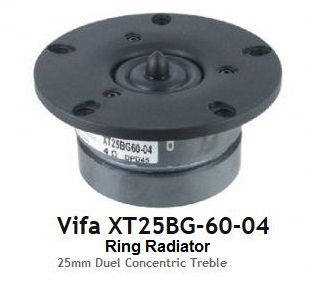
Must push the problems up higher, and a lot of people like them.
The second solution is a cone tweeter:
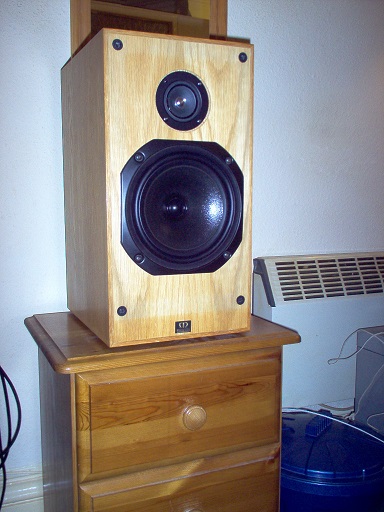
The theory says that as a cone goes into breakup, the radiating area simply diminishes IF it is sufficiently damped.
This is just my mathematical intuition, but I think any dome transducer or dustcap gets into trouble above a certain frequency. I am wary of delving into String Theory to justify this, because it really takes you close to the edge, but I got the notion from Stanford University's lectures by Prof. Leo Susskind on YouTube. And I did complete the course!
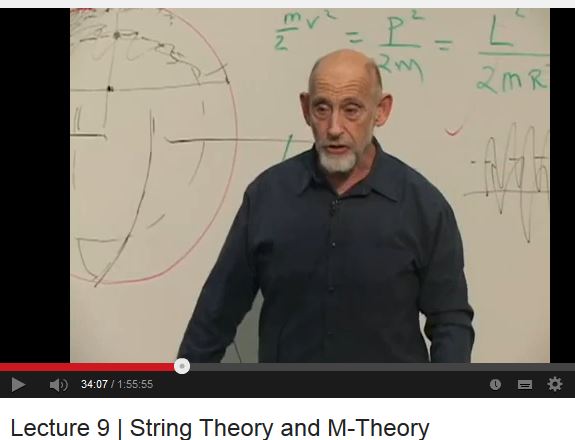
Waves on a Sphere just don't work. Waves on a Toroid do. And ring-radiators are Toroids. And, FWIW, earbuds and ribbons and AMTs are Cylinders. They work too, but as a lower dimensional solution.
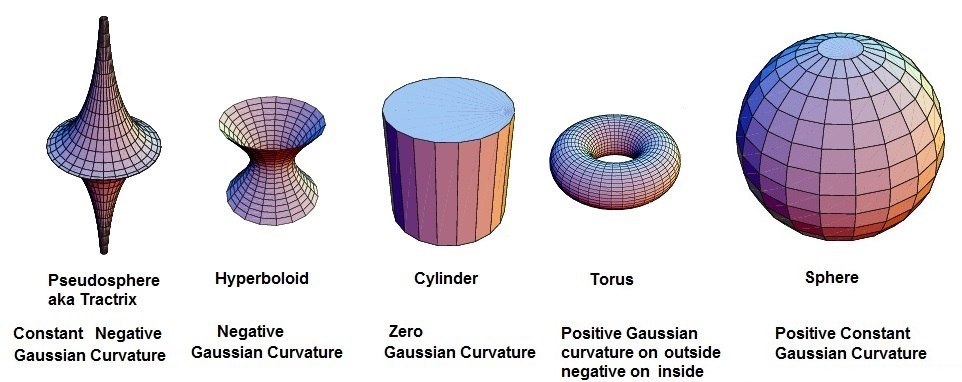
Now remember, shoot down the message, not the messenger. If you must. 🙂
Possibly a good approach is to swap out the various components. Be they source, amplification or final transducer aka speaker or headphones. Or cables. As has been suggested.
I had a badly soldered speaker cable with 4mm banana plugs that played havoc with my sound for years! 😱
YSDR, I think you are throwing a lot of money at very high-end tweeters. But IMO, if the final voice-coil, surround and dome has some issue, it really won't help.
I have toned down my opinions over the years, because I just don't like arguments, preferring discussion. But I have severe misgivings about using a dome-shaped piece of floppy silk covered in some damping goo as a high-frequency transducer. 😀
The problem with soft-domes is they have no rigidity whatsover. At some point around 5-6KHz, the centre moves in the opposite direction to the voicecoil edge that drives it.
I have often watched Flags on Portsmouth seafront go into uncontrollable flapping in a Gale. The end shreds into ribbons. Same thing really.
The simple fix is to pin the flapping centre, as with a ring-radiator like Vifa or SB Acoustics' efforts:
Must push the problems up higher, and a lot of people like them.
The second solution is a cone tweeter:
The theory says that as a cone goes into breakup, the radiating area simply diminishes IF it is sufficiently damped.
This is just my mathematical intuition, but I think any dome transducer or dustcap gets into trouble above a certain frequency. I am wary of delving into String Theory to justify this, because it really takes you close to the edge, but I got the notion from Stanford University's lectures by Prof. Leo Susskind on YouTube. And I did complete the course!
Waves on a Sphere just don't work. Waves on a Toroid do. And ring-radiators are Toroids. And, FWIW, earbuds and ribbons and AMTs are Cylinders. They work too, but as a lower dimensional solution.
Now remember, shoot down the message, not the messenger. If you must. 🙂
Last edited:
I agree with you to a point... if there was no such thing as a soft dome tweeter, and someone brainstormed the idea of making an almost-hemispherical diaphragm out of cloth stiffened with some resin, and driven by a voice coil from its outer perimeter... everyone (including me) would say "that is not going to work... there are a dozen reasons why it is a bad idea"
… But.... here we are today, and the soft dome tweeter works pretty well... it has been refined and tweaked for 50 years, and the good ones are very very good.
… But.... here we are today, and the soft dome tweeter works pretty well... it has been refined and tweaked for 50 years, and the good ones are very very good.
These are the options I'd give a closer look:
Clearly the 8" waveguide narrows things down a fair bit more than the 5". As a compromise between the two, maybe look at what this guy did (adapting Dayton RST28f to Visaton WG-148R).
Some sort of measurement setup is definitely advised either way.
I think dispersion for the first should be somewhat more even, going by data provided.I am considering a replacement tweeter in the place of the D3004/6600 and mating to the 6.5" midrange around 2 kHz, but there are more options in my mind.
1. SB26ADC + Augerpro's 5" waveguide for better directivity match to the mid.
3. Eighteen Sound ND1090 + XT120 horn for constant directivity.
Clearly the 8" waveguide narrows things down a fair bit more than the 5". As a compromise between the two, maybe look at what this guy did (adapting Dayton RST28f to Visaton WG-148R).
Looks like it solves one nagging problem of ribbon tweeters, which is good per se, but it would still require a waveguide to keep the horizontal dispersion in check, as found on the current ADAM S and T series speakers.4. Viawave GRT-145W-8 because it looks as an interesting option.
Some sort of measurement setup is definitely advised either way.
Thanks the responses guys!
The Viawave GRT-145W-8 is a waveguided version from the GRT serie, although not a large waveguide but more than nothing.
Maybe the SB26 + Augerpro WG have a smoother frequency response but the ND1090+XT120 have better/"moree even" dispersion, almost fully constant off-axis response from 2 to 10 khz, whereas the Augerpro WG have a more narrowing dispersion towards higher frequencies, at least as I see it.
And there are manufacturers that are bonded to soft fabric domes like Dynaudio.
Overall, I like my SS Illuminator tweeters, but sometimes they drive me almost to craze. And then it might even be that it's not their fault. Like system 7 said, sometimes it's not easy to track down the source of the problems.
The Viawave GRT-145W-8 is a waveguided version from the GRT serie, although not a large waveguide but more than nothing.
Maybe the SB26 + Augerpro WG have a smoother frequency response but the ND1090+XT120 have better/"moree even" dispersion, almost fully constant off-axis response from 2 to 10 khz, whereas the Augerpro WG have a more narrowing dispersion towards higher frequencies, at least as I see it.
And there are manufacturers that are bonded to soft fabric domes like Dynaudio.
Overall, I like my SS Illuminator tweeters, but sometimes they drive me almost to craze. And then it might even be that it's not their fault. Like system 7 said, sometimes it's not easy to track down the source of the problems.
The XT120 has narrow dispersion = more "forward" and "bright" sound.
After looking at your measurements, my guess is the combo of "active" + over-damped amplifier.
Have you tried a larger value cap. in series? (..something to "dull it" a bit.)
If you are committed to another tweeter I'd suggest one of the better Morel's (with a resulting slight loss in clarity..) for a less aggravating sound.
After looking at your measurements, my guess is the combo of "active" + over-damped amplifier.
Have you tried a larger value cap. in series? (..something to "dull it" a bit.)
If you are committed to another tweeter I'd suggest one of the better Morel's (with a resulting slight loss in clarity..) for a less aggravating sound.
It's Burns' Night in the UK.
That gloomy and dark time of year when we eat stodgy food like "Haggis and Neeps", possibly have far more Whisky than is healthy, and feel generally depressed:
But all is not lost! 😀
I built these soft-dome speakers (Morel CAT 298) with commendably high Qms woofers:
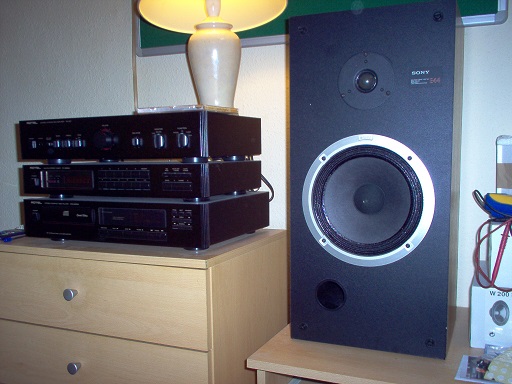
TBH, a complete shower! A top end dominated by fuzz and distortion! 😱
Much better was when I worked my 4th. order crossover magic on a cone tweeter:
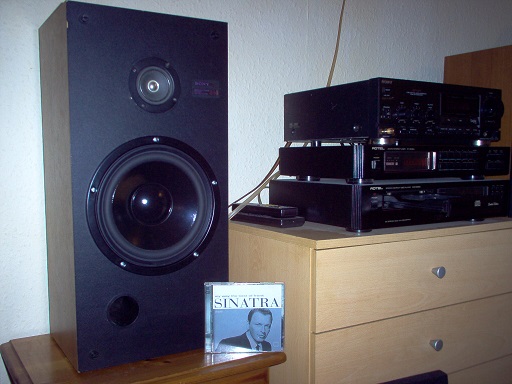
A few details about the Monacor HT22-8 cone tweeter:
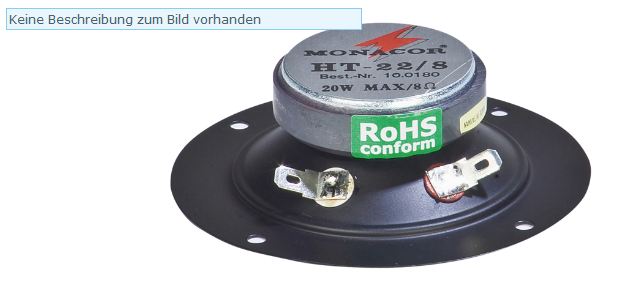
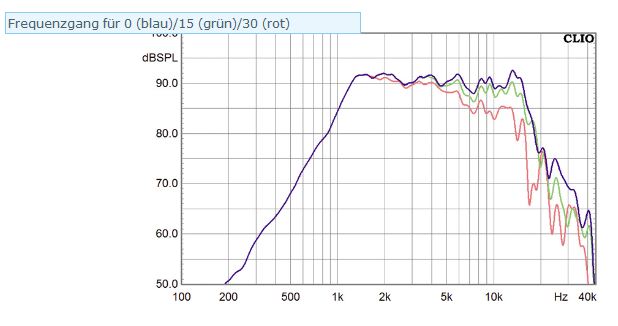
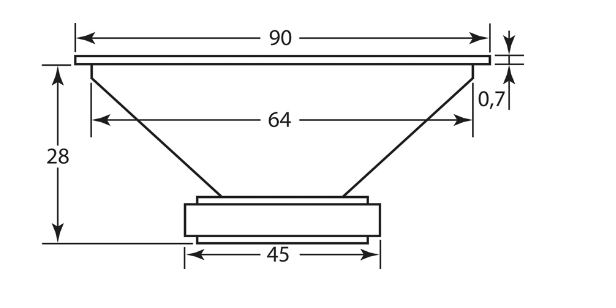
Musical to the max. No fuzz and distortion. Gets you in touch with your inner "Barry White". I don't know what to call it. Slam and attack?
That gloomy and dark time of year when we eat stodgy food like "Haggis and Neeps", possibly have far more Whisky than is healthy, and feel generally depressed:
Rabbie Burns said:Ye flowery banks o' bonnie Doon,
How can ye bloom sae fair;
How can ye chant, ye little birds,
And I sae (weary) fu' o' care!
But all is not lost! 😀
I built these soft-dome speakers (Morel CAT 298) with commendably high Qms woofers:
TBH, a complete shower! A top end dominated by fuzz and distortion! 😱
Much better was when I worked my 4th. order crossover magic on a cone tweeter:
A few details about the Monacor HT22-8 cone tweeter:
Musical to the max. No fuzz and distortion. Gets you in touch with your inner "Barry White". I don't know what to call it. Slam and attack?
Ironic. I have a system with a very good cone tweeter, but a cone tweeter is nothing but resonances above a certain freq.. Look at any non-smoothed freq. plot. It's more like a poor-man's electrostat (..which is why I like it).
I would NOT recommend this for someone who is looking for something less "aggravating".
Morel's tweeters do have a rising 2nd order higher in freq.. but I doubt anyone would hear it at normal listening levels. "Fuzzy": sure - it doesn't have the perceived "clarity" of a hash-freq. response of the cone tweeter. (..note: this is in part due to our hearing referencing the average closer to the "peaks" of the freq. response.) By that same subjective response: they aren't as "dynamic" either (..though this is true for most domes regardless of their diaphragm material).
The Morel's also depend on the model, how they are used, and if they are using ferrofluid or not. (..the ferrofluid models have slightly less clarity but lower distortion (mostly higher order) lower in freq. on average.)
..note: I'm also not fond of the double ring designs - perceived depth is almost always limited.
I would NOT recommend this for someone who is looking for something less "aggravating".
Morel's tweeters do have a rising 2nd order higher in freq.. but I doubt anyone would hear it at normal listening levels. "Fuzzy": sure - it doesn't have the perceived "clarity" of a hash-freq. response of the cone tweeter. (..note: this is in part due to our hearing referencing the average closer to the "peaks" of the freq. response.) By that same subjective response: they aren't as "dynamic" either (..though this is true for most domes regardless of their diaphragm material).
The Morel's also depend on the model, how they are used, and if they are using ferrofluid or not. (..the ferrofluid models have slightly less clarity but lower distortion (mostly higher order) lower in freq. on average.)
..note: I'm also not fond of the double ring designs - perceived depth is almost always limited.
Last edited:
I'll second what Steve said, don't just concentrate on the tweeters. Try a different amp and see whether it is better or worse, maybe a different source/DAC....
I know that my LM3886 amp is noticeably more sibilant driving my mtm's than my hitachi mosfet amp. Looking at the freq response of the two amps, the mosfet amp is about 0.1db down at 20Khz compared to the LM3886 which really should not make a difference to audibility.
I picked up that you are crossing at 2.1Khz, you might want to have a read of this post and subsequent ones Can you have sparkling treble but without sibilance The entire thread has some very worthwhile content.
Tony.
I know that my LM3886 amp is noticeably more sibilant driving my mtm's than my hitachi mosfet amp. Looking at the freq response of the two amps, the mosfet amp is about 0.1db down at 20Khz compared to the LM3886 which really should not make a difference to audibility.
I picked up that you are crossing at 2.1Khz, you might want to have a read of this post and subsequent ones Can you have sparkling treble but without sibilance The entire thread has some very worthwhile content.
Tony.
Last edited:
I'll second what Steve said, don't just concentrate on the tweeters. Try a different amp and see whether it is better or worse, maybe a different source/DAC....
It's a plate amp with dac/dsp/crossover.. he's "locked-in" to his system. 😱
-one of those rare occasions where you actually are better off with a different driver (or perhaps a large value series cap and/or resistor).
Last edited:
Yes, the plate amp would remain. The logic with the use of passive components is to create a higher impedance somehow that is better for the amp-driver interaction? Or just to mask some flaws with other flaws (passive components imperfection)? Just asking.
Some amps may be a little uncomfortable with a reactive load. Passive speaker level components would be the solution to such an issue. The goal may be higher as you suggest, or simply more consistent.
Damping (electrical and mechanical): tends to "dull" things out a bit.
Maybe a larger uf "motor run" cap from Cornell/D ..and if you like it, you can try and get-back some of that clarity with small Miflex copper bypass (without screwing up the dulling effect the cap provides).
ex.
Cornell Dubilier Electronics (CDE) SFT44T50J291B-00DU
-you will need to give it several days of "run-in" to get the best from it.
Maybe a larger uf "motor run" cap from Cornell/D ..and if you like it, you can try and get-back some of that clarity with small Miflex copper bypass (without screwing up the dulling effect the cap provides).
ex.
Cornell Dubilier Electronics (CDE) SFT44T50J291B-00DU
-you will need to give it several days of "run-in" to get the best from it.
I think a lot of us have had a hard time with soft dome tweeters.
The waveguide metal SEAS DXT is one I'd like to try too:
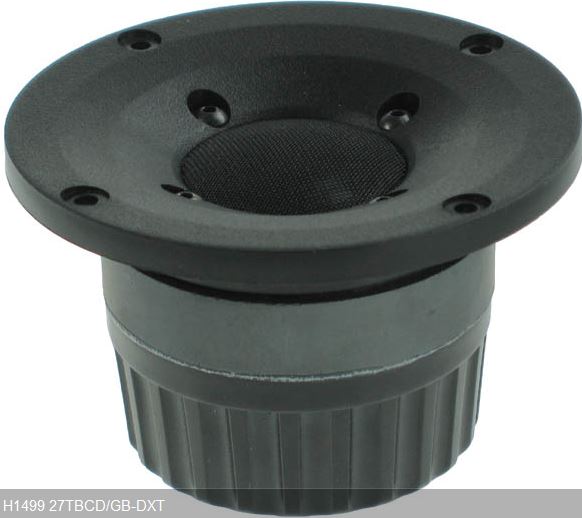
IMO, any tweeter sounds best 4th order filter above 3kHz. Low order and low crossover point seems to make things worse.
Interesting. I have the older Seas Magnum tweeters, after trying out the SS9900 and Morel Supreme ST1048. I found the Seas to match my Accuton 5" midrange better, at around 2300hz with 4LR active. If I cross higher, my power response looks less good, even though I know it cant be optimum, before I enter the waveguide territorium 😎
"IMO, any tweeter sounds best 4th order filter above 3kHz. Low order and low crossover point seems to make things worse."
Yeah, this seems like a very crude generalization, more so because I don't know who is listening to a tweeter without a mid or midwoofer and nowadays better tweeters are designed to play much lower than 3 kHz anyway. True, there are tweeters that have problematic lower range but not all like this.
Yeah, this seems like a very crude generalization, more so because I don't know who is listening to a tweeter without a mid or midwoofer and nowadays better tweeters are designed to play much lower than 3 kHz anyway. True, there are tweeters that have problematic lower range but not all like this.
Last edited:
I do not make measurements but I have heard many tweeters of different topologies. I have found that the Audax TW034 with the TG waveguide meets all the expectations I need.
The limitations of the original fabric dome tweeter have long been overcome, (as noted here hifijim).
Let's not forget that the measurements you see on your screens or in the graphics provided by the manufacturers is never what you can really hear.
There are some very good online FR tests, do it and you will find that it is not necessary to "spin so fine"
The limitations of the original fabric dome tweeter have long been overcome, (as noted here hifijim).
Let's not forget that the measurements you see on your screens or in the graphics provided by the manufacturers is never what you can really hear.
There are some very good online FR tests, do it and you will find that it is not necessary to "spin so fine"
Last edited:
- Home
- Loudspeakers
- Multi-Way
- Treble, how to be good?